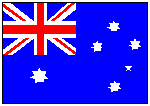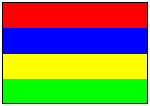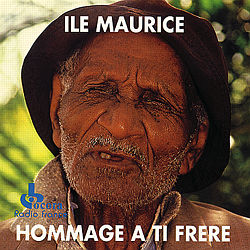

![]()

Sega Dance - Mauritian Folklore
Ti Frere "King of the Sega"
 |
|
|
|
The Real TiFrère Jean Alphonse Ravaton, alias Ti Frere, was born on April 29th, 1900. His father was Madagascan ( Ravaton is a Madagascan surname) and a sega artist too, the art form being characteristically passed on from father to son, and groups often made up of members of the same family. A coachman to a well-to-do-family, his father not only performed the sega but also conducted a dance band, the kind prolific at the time with accordion, banjo, percussion, and sometimes violin. Such orchestras performed European dance repertoire like the "cottish", "mazok", "lavalse" and "quadrilles", dances which, although they have disappeared in Mauritius, are still popular on Rodrigues, the neighbouring island. Ti Frere learnt to sing the sega and ballads too through accompanying his father. Later he would sing with his own dance band, playing especially for " zarico" (z’haricot) (bean) dances. "Zarico" dances were Saturday night country affairs put on in the courtyards of homes and during which a cake containing a bean was shared out: whoever got the bean had to put on the next Saturday’s dance. These dances would always finish with a few segas, something that still happens today at marriages or parties and that harkens back to the time when the sega, frowned upon and sometimes forbidden, was only danced as the night would close and restrictions eased up a little. The segas marginally never threatened its existence: Ti Frere has performed it all his life. He would be called upon for parties, beach picnics, drinks after shooting parties which he himself would participate as a beater and sometimes as hunter. His sega artist reputation was firmly established through veritable tournaments, "pariages sega", contests with no prize and no jury, put on from village to village, which would last all night long, even today into the next day with only judges being the dancers and their audience. Although Ti Frere was reputed locally, he had to wait until 1964 to achieve fame on a national scale. On October 30th of that year occurred the famous " Night Of the Sega". Held on Mt. Le Morne, it was a musical and theatrical happening which Mauritians still remember. In some ways this happening was the official reinstatement of the sega and the first step towards an awareness of Afro-Mauritian cultural identity. Four years away from independence and cohabitating with Indian, Moslem, European, Chinese ethnic groups, the Afro-Mauritian, so called Creole community felt the need to assert its identity through a rediscovery and conservation of its roots. On that night a sega contest was organised after which Ti Frere was crowned " King of sega". From then on, he was in the public eye and recorded a series of 45’s which are unobtainable today. To the traditional ravanne, maravane , and triangle, Ti Frere would sometimes add the accordion, influenced by his father (and his own) dance band instruments. Like other sega artist , Ti Frere has never been able to live from it. He has had many different trades: wood cutter, cane-cutter, " casseur roches" (boulder breaker), bus conductor, forester. Ti Frere has artistry that is totally unique. This is in part due to his strong artistic personality but also to what has influenced his make-up. Ti Frere was initiated by his father, but the latter had already been triply influenced by the Bohjpuri language, his Madagascan birth ( Ti Frere still remembers the Madagascan songs his father taught him) and by his contact with the European dance music performed by his orchestra, music and in other towns no doubt also influenced his father. According to A.Pitot (1910), vestigates of this music still live on in the sega , just as in new Orleans, Blacks were imitating bands on parade. This unique situation made Ti Frere a synthesis of African and European roots, and able, by assimilation away from the structure of African-inherited classical sega ( drumcall, soloist, choir), to adopt a form inspirited by European models: Sega’s with verse and a refrain sung from beginning to end by a soloist where melody counted above all. The " drawing room sega" followed similar lines but Ti Frere remained traditional without losing any of the rhythmic intensity and inspiration of the original rhythmic framework and ravanne sega instrumentation. American bluesmen too left far behind them the songs of their ancestors, especially work songs, opting for newer European forms and instrumentation and creating unique new forms of expression- the old songs lived on nevertheless and evolved quite naturally into Negro Spirituals. Ti frere, without losing any of the rhythmic intensity and inspiration of the original sega art from has written superb melodies. This is how segas were born, even if their repertoire is
now well-known to all Mauritians. Simple everyday things would take them off: words of advice to a drunkard, for a neighbours child, domestic rows... |
||
| Philippe OnLine brings you the following sega sound clips from Ti Frere and his Troupe. (Click on title for access) | ||
|
||
|
C'est avec surprise et beaucoup d'émotion que nous avons recu de Lucien Putz, des copies d'articles parus sur Ti Frère. Nous avons le très grand plaisir de les publier sur l'internet pour vous. Cliquez sur la liste à votre droite pour les lire.
Merci Lucien. "Voici comme promis les coupures de presse concernant l'enregistrement de Ti Frère. J'ai sélectionné les principaux articles: reportages sur l'enregistrement ou articles que j'ai écrit pendant la semaine d'enregistrement. En relisant ce que j'ai écrit, je me rappelle à quel point toute cette aventure m'a marqué émotionnellement car je ne suis pas habitué à cela: une histoire d'amitié privée qui est devenue une affaire médiatique, mais l'essentiel, c'est que grâce au CD, Ti Frère restera un peu avec nous, et grâce à votre intiative sur Internet, il se balade dans les étoiles et arrive dans n'importe quel foyer du monde!!"-Lucien Putz Email de Lucien: lucien.putz@12move.be |
|
|
|
Artists who do not wish to have their music promoted on this site, please advise and we will remove the clips accordingly. On the other hand, artists who wish to have their music promoted, please send us a CD or cassette and we will include clips of your music. |
||
| The Sega
Wherever she came into contact with the outside world, Africa’s influence was profound. When the slaves left, they went empty-handed with nothing but their memories, voices, bodies, so initially this influence was an oral one: it was song, rhythm and dance. And these traces of Africa grew, despite their new masters’ world. This was how the sega evolved into the traditional song and dance of the people of Mauritius and Rodrigues, and other Indian Ocean islands too, like Seychelles and Reunion Island. Sega is music of exiles. Slaves would get together at night after a long days work and tell stories. They would make up "sirandanes" ( Creole riddles) and sing for their lives, of their feelings, dancing all the while to those rhythms which had been their own on African soil. Ancient sega also had magical, sacred function and was inseparable from life’s most important moments from birth to death. The "Death Sega", for example, accompanied funeral rites. This was danced around the coffin as certain rhythms were played on all sorts of resonant objects to chase away the spirit of the death. Eight days following a death would be consecrated to the memory of the deceased and the occasion for vigils during which all was done to encourage the dead man’s spirit to depart. On the eighth day a sega should be organised with theatrical performance of fables and fairy-tales done by masked, fancifully dressed actors. All this is a thing of the past. Sega seems to have lost its ritual character around the turn of the century , remaining pure entertainment. Sega is a kind of improvised, and often rather juicy account of life’s ups and downs, the Creole language being perfectly suited to this art form with its great plasticity, its plays on words , double-barrelled meanings and onomatopoeia., all dispensable to a sega performance. With a past closely linked to magic, its highly erotic dancing and its overt on words often aimed no doubt at the powers that be, the sega found no favour, with the Church and civil authority and was frowned upon, often even banned. After the abolition of slavery, Blacks left the sugarcane plantations, forming settlements on the banks of the Rivere Noire, in Mahebourg and a few other sites. Ancient classical sega, kept alive and thriving in these Afro-Mauritian communities, took the form of a drum call followed by a presentation of the main theme, generally improvised by a woman and repeated incessantly by a chorus until they had created an obsessional atmosphere stimulating to the dancers (cf. Ocora C 590005, Mauritius: Mauritian ravanne sega and Rodrigues drum sega.) This sega, the so called "Ravanne sega" named after the ravanne which was the main percussion instrument used, remained close to the original art form and was in some respect the prototype of the "real thing". But along side this, the Blacks and Metis who lived in closer contact with their former masters, developed a more "civilised" form of sega. They would put on segas at parties or to honour guests. Yet it was in some form the first rehashed sega, rather subdued and inoffensive. They called this the " dans la cour grand’case" sega and it was later followed by even more Europeanised sega one even more toned down and adapted to urban culture, the so-called "drawing-room sega". Jacques Cantin was the first, back in the fifties, to get the sega on the air. He was soon followed by Serge Lebrasse and others, which led to today’s modern sega with its hit tunes and its stars. This kind of sega can be heard in homes or in public places likes disco’s or tourist hotels. Between this type of sega which could be classified as urban- some would say commercial- with its electric guitars, synthetiser and drums, and the traditional sega of Afro-Mauritian commuities like those of Riviere Noire and Mahebourg (of which the most notable exponent is the group Z’enfants Ti Riviere (Ocora C 590005), another type of sega has sprung up. Although steeped in tradition , it has been strongly influenced by Western popular music, a sega that could have evolved only through men with their feet in both worlds, an amalgam of the cultures of Africa and European land-owners. Men who, through their particular work, were called to move in the circles of White land owners while continuing to live in their villages. The sega artistry of Ti Frere is just that, a product of the assimilation of these two models. |
||
 The Instruments
|
The Dance Email us at philippe@enternet.com.au Sega is alive and well in Canada
|
|
Extract on TiFrere is from the booklet accompanying the CD Homage a Ti Frere.
Certain descriptions have been borrowed from Jean Erenne, Alain Desmarais and Jean-Claude Deojee who devoted his masters thesis to the sega: < The Origins and Evolution of the Sega>, Universite-Paris III.
Lucien Putz, Translated by Jeffrey Grice.
Designed and compiled by Madeleine and Clancy Philippe
Information contained in this homepage is given as supplied and in good faith. No responsibility is taken for any losses or misgivings which may arise from the use of any supplied information. We welcome emails bringing to our attention any inaccuracies or suggestions for improvement.
Copyright Clancy J Philippe - Updated May 2001